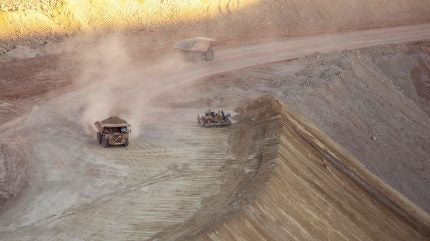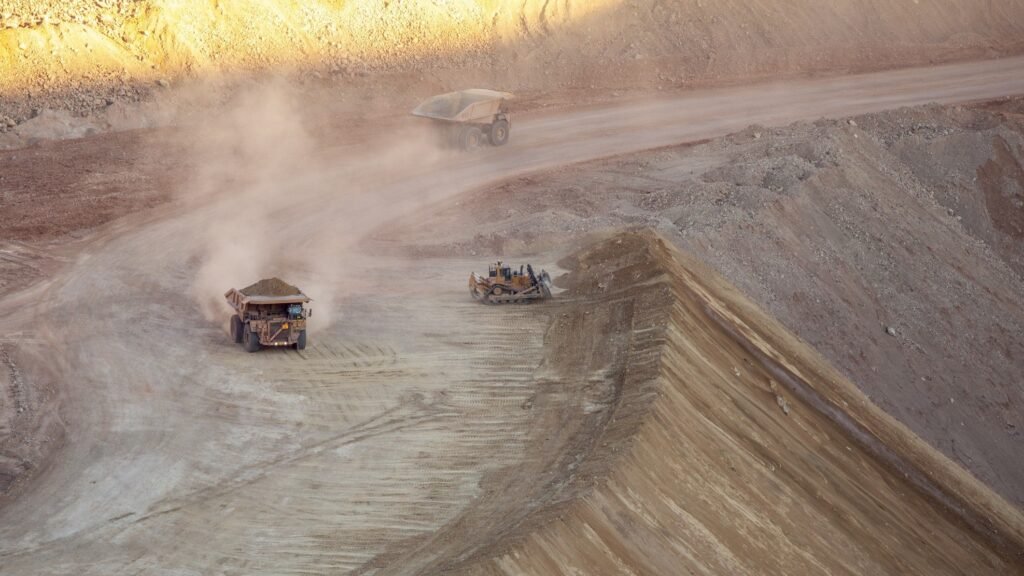
The US is home to 5.5% of the world’s copper reserves – the sixth-biggest share globally. However, it has long been dependent on imports to meet demand from its energy, defence and technology sectors, ranking as one of the top five consumers of copper globally.
In 2024, the US imported 810,000 tonnes (t) of refined copper, valued at an estimated $10bn. This figure represents a 5% increase from the 771,000t imported in 2023.

Discover B2B Marketing That Performs
Combine business intelligence and editorial excellence to reach engaged professionals across 36 leading media platforms.
The growing figure is a problem in the eyes of the Trump administration. Commerce Secretary Howard Lutnick has voiced the White House’s intention to “bring copper home”, turning to Trump’s “most beautiful word” – tariffs – to push domestic growth.
However, copper production isn’t a sector for which tariffs offer a quick fix. Reserves are plentiful and demand is high, but the US is notoriously slow to permit new development and lacks the infrastructure to compete with China in terms of refinement. These obstacles, alongside a recent nosedive in copper prices, paint a picture of a US sector still a long way from self-sufficiency.
The market impact of Trump’s copper tariffs so far
Trump’s tariffs were supposed to signal a new beginning for domestic copper. In July, he announced that an investigation under section 232 of the Trade Expansion Act had determined that “copper is being imported into the United States in such quantities and under such circumstances as to threaten to impair the national security of the United States”.
In response, Trump imposed universal 50% tariffs on imports of semi-finished copper products (copper wires, pipes, rods and sheets) and copper-intensive derivative products (cables, pipe fittings and electrical components).
The market was not surprised by the introduction of tariffs. What it was surprised by, however, was that refined copper was not immediately included, with recommendations instead made for a phased universal tariff of 15% on refined copper, starting in 2027, and 30% starting in 2028. The surprise was evident in copper futures, which suffered the biggest single-day drop on record, plummeting from $5.63 on 30 July to $4.35 on 31 July.
Considering the reasons behind the nosedive, Jeffrey Lorch, a partner at McKinsey, explains that “because people expected tariffs, there was a lot of advanced purchasing of copper to try to build up a stockpile; they expected that this tariff would move to an import parity situation, which would allow a buck to be earned on this stockpile.
“What actually happened was that the tariff announced was underwhelming.”
On the international picture, he says: “This essentially led the differential between the COMEX [the Commodity Exchange] and the LME [London Metal Exchange] to collapse at the end of July. From a long-term perspective, copper is still a bullish commodity – there are a lot of investment plans being announced in the US and elsewhere to develop it – but that major differential between the LME and the COMEX is not what it was.”
It appears that supply chain security ultimately took precedent over bolstering US refined copper, a nod to the difficulty of rapidly supercharging the domestic sector. However, domestic ambitions remain front and centre in the administration’s plans for copper: from 2027, the government is considering 25% domestic sales requirements for copper input materials and for high-quality copper scrap, as well as export controls for high-quality copper scrap.
However, seriously reshaping the market in favour of domestic supply chains will require significant investment and a regulatory overhaul.
Copper doesn’t grow on trees: the hurdles to monetising US reserves
Copper production will grow relatively quickly in the US. GlobalData, Mining Technology’s parent company, forecasted in its 2024 Global Copper Mining report that US copper production would see robust growth at a compound annual growth rate (CAGR) of 6.5% from 2024 through to 2030, while its copper consumption would increase at a CAGR of 1.57% over the same period.
Most of this predicted production growth is set for the end of Trump’s term or beyond, when new projects and capacity expansions are expected to commence. These include expansions at Freeport-McMoran’s Bagdad and Lone Star mines, both in Arizona. The Bagdad mine is currently waiting on a final investment decision, expected later this year ahead of a planned start-up in 2029. If it goes ahead, it will increase US copper production by an estimated 90,700–113,400t annually, while the Lone Star expansion – currently at the pre-feasibility stage – aims to deliver 136,100–181,400t per year, starting in the early 2030s.
The anticipated growth is good news for copper hopefuls in the US. However, more copper does not immediately equate to more refined copper, and the US’ biggest challenge lies not in mining but in processing.
Gayathri Siripurapu, associate project manager at GlobalData, explains that “despite this robust growth, domestic refining capacity remains inadequate to meet demand, with a widening supply gap. This gap poses a strategic vulnerability, intensified by global competition for copper driven by the energy transition. Refining expansion faces capital, regulatory and environmental barriers, requiring long investment cycles.”
Currently, the global copper refining scene is dominated by China. The Institute of Materials, Metals and Mining reports that China currently controls 97% of global copper smelting and refining capacity. It also notes that China has added nearly 11 million tonnes (mt) of copper and alloy capacity since 2019, representing approximately 80% of global additions.
Chinese smelters are predominantly operated by state-owned enterprises, offering them market resilience and, historically, financial support. Lorch explains that “the economics are challenging relative to China, particularly when China has a much more capital-efficient approach of building on copper smelting capacity”.
Ian Lange, professor of economics and business at the Colorado School of Mines, adds that: “The US will have to compete with the Chinese smelters that are being built, which are going to have nearly zero cost of capital and some implicit government subsidy through sales to downstream manufacturers. If you are competing with them, well, good luck to you.”
To smelt or not to smelt?
There is a general consensus amongst analysts that competing with China’s smelting infrastructure is futile and that efforts to expand US copper production would be better spent elsewhere. If Trump’s administration means to reshape supply chains to “bring copper home”, it is smelting and refining that will prove to be the biggest obstacle.
The US currently has two operational primary copper smelters: Rio Tinto’s Kennecott smelter in Utah and Freeport-McMoRan’s Miami smelter in Arizona. A third smelter, Grupo Mexico’s Asarco Hayden facility in Arizona, was closed in 2019 due to labour disputes; those disputes have been settled, but the smelter has not been reopened.
Siripurapu points to the data: “The US produced an estimated 1.1mt of copper in 2024, of which more than 20% is exported for refining overseas. On the other hand, the country’s domestic refined production including primary ore and secondary (from scrap) was 1.04mt. During the same period, the country’s refined copper consumption stood at 1.8mt.”
The shortfall between US copper demand and production suggests that more smelters are a logical solution. However, Lange doesn’t expect to see investment in US copper smelters any time soon: “It is a common talking point, smelting capacity, but look at the data: if net smelter returns are negative, then we don’t need more smelting capacity.”
Recent commentary by the Centre for Strategic and International Studies supports Lange’s take. It notes that 2025 saw smelting charges fall to $45/t in the US, a historic low at which the country’s copper smelters are effectively operating at a loss.
The falling charges are in part due to current ore shortages, which have hit smelters across the globe, but paired with China’s predominance, it creates a discouraging backdrop for potential smelter investors.
“There are people talking about it, but I can’t take it seriously while everybody [in the US] is losing money and our competitor [China] is not,” Lange summarises.
Copper production: the permitting problem
GlobalData reports that the US had 55mt of copper reserves in 2024, yet the key sticking-point for accessing these is the bureaucracy surrounding permitting new mine development, which can take between seven and ten years to navigate. Potential developers need approval, often at several levels (federal, state and local agencies), and the process tends to be fragmented and repetitive.
The issue has long been a concern to the industry and was flagged repeatedly in the Biden-Harris administration’s 2023 report, Recommendations to Improve Mining on Public Lands. Industry letters published in the findings specifically pointed to difficulties navigating the National Environmental Policy Act (NEPA), with one noting that: “NEPA can unfortunately be manipulated to use appeals and litigation to purposely create lengthy and costly project delays that have little or nothing to do with the merits of a case.”
In April, the Trump administration began using the FAST-41 programme (which acts as a legal framework for regulatory streamlining) to accelerate critical mineral projects slowed by NEPA (and other) regulations.
Since then, ten US mining projects have received ‘covered’ status, whilst 34 have received ‘transparency’ status, at least nine of which relate to copper production. Those with ‘transparency’ status are publicly posted to provide accountability around the permitting process, while those with ‘covered’ status receive the benefits of a coordinated fast-tracking process.
Overhaul of regulatory frameworks takes time, but Lange thinks the US is moving in the right direction. “Firing workers in the federal government probably isn’t helpful to getting these things done, but all the talks are going in the right direction towards faster permitting, and there are fewer concerns about double checking environmental impact statements.”
There is cautious optimism on the regulatory front, but Siripurapu warns of other obstacles to increased copper production that will be harder for the US to surmount.
“The US is laying groundwork for growth in domestic copper mining and refining, but meeting full demand domestically will take years, requiring large investments, regulatory streamlining and expanded recycling efforts.”
She concludes: “Without significant infrastructure development, the US will remain heavily reliant on imported refined copper in the near to medium term.”


